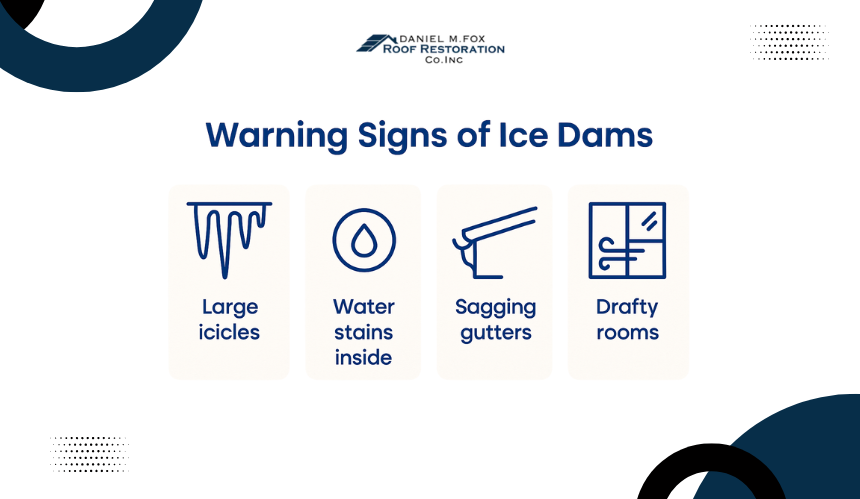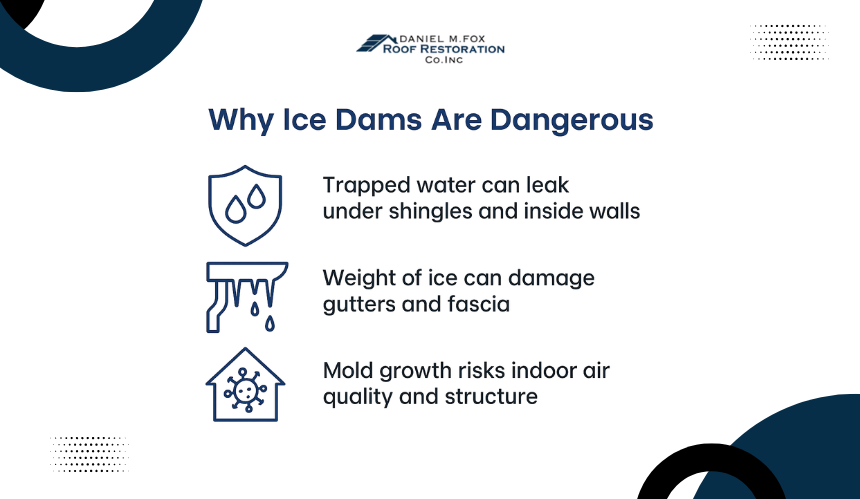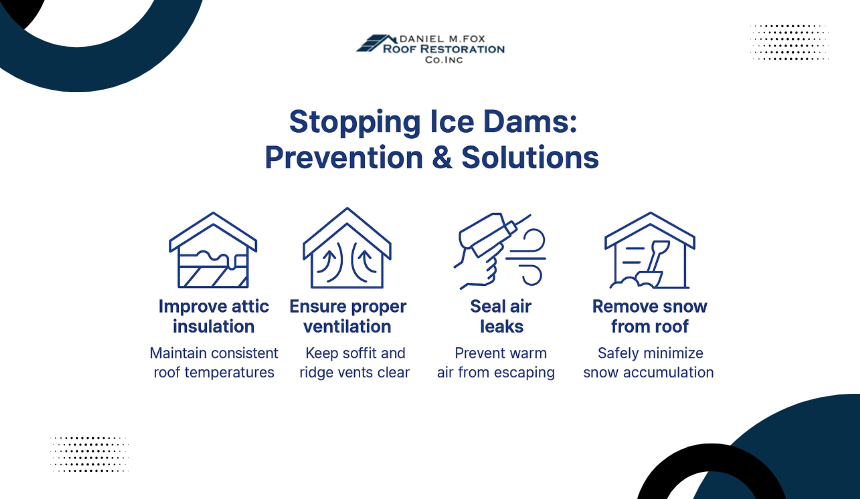Ice dams are one of the most frustrating problems homeowners face during cold winters. They form when heat from inside the home melts snow on the roof, only for that water to refreeze near the roof’s edges.
Beyond visible damage, ice dams can reduce energy efficiency and create conditions for mold growth inside your home. The longer they go untreated, the higher the repair costs climb.
In this guide, you’ll learn the science behind ice dams, how to spot early warning signs, and proven strategies to stop them before they cause expensive damage.
What Are Ice Dams?

An ice dam is a thick ridge of ice that develops along the lower edge of a roof when melting snow refreezes before it can drain into the gutters. Unlike simple icicles, which may look harmless, ice dams create a frozen barrier that traps water on the roof surface. This standing water can eventually find its way under shingles and leak into the attic or walls.
What Conditions Lead to the Growth of Ice Dams?

Ice dams do not form randomly. They are the result of specific conditions that allow snow to melt unevenly and refreeze at the roof’s edge. Four of the most common causes include:
- Poor insulation: Inadequate attic insulation allows heat to rise through the ceiling. This warms the parts of roof deck and causes uneven snowmelt that later refreezes near the eaves.
- Inadequate ventilation: Without proper soffit and ridge vents, roof temperatures fluctuate, creating hot and cold zones that make ice formation more likely.
- Clogged gutters: Gutters blocked by leaves, twigs, or existing ice trap water along the roofline. This water quickly refreezes and adds to ice dam buildup.
- Roof design: Low slopes, valleys, and complex rooflines naturally slow drainage and create cold spots where melted snow tends to collect and freeze.
Understanding the science behind ice dam formation is the first step to controlling them. They are not just a cosmetic winter nuisance but a direct result of how a roof interacts with insulation, ventilation, and outdoor conditions.
What Are the Signs of Ice Dams on Your Roof?

Spotting an ice dam early is the best way to minimize damage. Common warning signs include:
- Clusters of large icicles: Heavy icicles hanging from roof edges or gutters often signal trapped water backing up behind frozen ridges.
- Water stains inside the home: Brown or yellow marks on ceilings or walls are signs that water has seeped beneath shingles and into living spaces.
- Sagging or ice-filled gutters: Excess weight from frozen water strains gutters and fascia boards, often worsening the blockage.
- Drafty rooms and uneven temperatures: Cold spots inside the house may indicate heat escaping into the attic, fueling the cycle of melting and refreezing.
By understanding both the formation process and the early warning signs, homeowners can act quickly before leaks, structural damage, or mold growth become serious problems.
Why Are Ice Dams Dangerous for Your Home?

Ice dams may appear to be just frozen ridges or clusters of icicles, but the damage runs much deeper. Trapped water seeps under shingles and into the roof deck, eventually reaching ceilings, walls, and insulation. This leads to peeling paint, stained drywall, and mold growth that threatens both structural integrity and indoor air quality.
The weight of accumulated ice also strains gutters, downspouts, and fascia boards. As gutters sag or pull away from the home, drainage problems worsen, creating a cycle of more pooling and freezing. In severe cases, this added stress can damage shingles, loosen fasteners, and shorten the overall lifespan of the roof.
Beyond visible repairs, energy efficiency also suffers. Wet insulation loses its effectiveness, allowing more heat to escape through the attic and fueling additional melting. This creates higher heating costs while also increasing the likelihood of repeated ice dam formation.
How Can You Prevent Ice Dams Before They Form?

Preventing ice dams begins with keeping the roof cold and ensuring melted snow can drain properly. Seasonal measures that lower the risk include:
- Check attic insulation: Ensure existing insulation is evenly spread and in good condition to keep the roof surface consistently cold during winter.
- Maintain roof ventilation: Keep soffit and ridge vents clear of obstructions so cold outdoor air can circulate and balance roof deck temperatures.
- Seal attic air leaks: Closing gaps around chimneys, recessed lighting, and attic hatches stops heat from escaping upward. Reducing warm air leakage lowers both heating costs and roof stress.
- Maintain clean gutters: Clear gutters allow melted snow to drain freely instead of pooling and freezing near the eaves. Proper drainage prevents ice buildup and protects fascia boards.
- Remove snow safely: Using a roof rake after heavy snowfall reduces the amount of snow available to melt and refreeze. Light snow removal lessens roof load and minimizes refreezing cycles.
Proactive prevention not only reduces the chance of ice dams but also improves overall energy efficiency and lowers heating costs.
What Can You Do If Ice Dams Have Already Formed?
If an ice dam is already on your roof, quick action can reduce damage while you plan for permanent fixes. Safe, temporary solutions include:
- Use a roof rake: Removing snow from the lower roof reduces the amount of melting snow that feeds the dam. Always work from the ground to avoid damaging shingles or risking injury.
- Apply calcium chloride socks: Placing a cloth tube filled with calcium chloride across the dam melts small channels, giving trapped water a path to drain.
- Avoid harmful methods: Never chip at ice with sharp tools or use rock salt, which can damage shingles, gutters, and landscaping.
- Call for professional steam removal: Roofing specialists use low-pressure steam equipment to melt ice dams safely without harming the roof deck or shingles.
These steps provide short-term relief, but they are not permanent fixes. To stop ice dams from returning, homeowners need to address insulation, ventilation, and air leaks.
When manual snow removal is unsafe or impractical, a roof snow removal service can clear heavy buildup without risking damage to shingles or gutters.
Permanent Solutions to Ice Dams for Long-Term Protection
Temporary fixes help reduce immediate damage, but permanent protection requires structural improvements that keep the roof cold and prevent uneven melting. Proven long-term solutions include:
- Install an ice and water shield: A waterproof underlayment beneath shingles in valleys and along eaves blocks water infiltration if dams form.
- Use heated roof cables: Strategically placed cables melt narrow channels in the ice, allowing water to drain safely. They are especially useful on roofs with heavy snow loads.
- Upgrade attic insulation: Install high-performance insulation with proper depth and coverage to eliminate heat loss that contributes to uneven snowmelt.
- Improve ventilation systems: Redesign or upgrade your ventilation system to create continuous airflow across the entire roof deck. This prevents hot and cold spots.
- Schedule professional inspections: Roofing experts can identify insulation gaps, poor ventilation, or roof design flaws that make ice dams more likely.
Protect your home this winter with reliable roofing, gutter care, and roof snow removal service. Daniel Fox Roofing Inc. provides expert solutions that clear heavy buildup and stop ice dams before they cause damage. Keep every roof and gutter system safe, efficient, and ready for the season.
Frequently Asked Questions
Do icicles always mean there is an ice dam?
Not always. Small icicles can form from normal melting snow, but large clusters combined with roof-edge ice buildup often signal the presence of an ice dam. Icicles linked to ice dams usually appear near eaves and gutters where trapped water refreezes instead of draining properly.
Can ice dams cause roof leaks in just one winter?
Yes. Even a single season of ice damming can push water under shingles and into the attic, leading to leaks, stained ceilings, and insulation damage. Moisture intrusion from a first-time ice dam can also weaken roof decking and promote hidden mold growth in attic spaces.
Are ice dams covered by homeowners' insurance?
Coverage depends on the policy. Many insurers cover water damage caused by ice dams, but not the cost of removing the dam itself. Checking policy details is essential. Policies typically address “sudden and accidental” damage, which makes prevention and routine roof maintenance especially important.
What type of roof is most vulnerable to ice dams?
Low-sloped roofs, complex rooflines with valleys, and homes with insufficient insulation are most prone to recurring ice dam formation. These designs create cold zones where snowmelt collects, increasing the likelihood of refreezing and heavy ice accumulation.
Is it safe to use salt to melt an ice dam?
No. Rock salt and common de-icing salts can corrode shingles, gutters, and metal roofing. Calcium chloride is the safer choice, but it should always be applied in socks or tubes to prevent roof damage and allow controlled melting. Other safe alternatives include using a roof rake to clear snow from lower sections and sealing attic air leaks to limit heat loss that contributes to refreezing.
How do heavy snow loads affect ice dam risk?
The more snow sitting on the roof, the greater the chance of uneven melting and refreezing. A professional roof snow removal service helps reduce this risk safely. Excess snow also adds structural weight, which can stress rafters, gutters, and roofing materials beyond safe limits.
Can metal roofing prevent ice dams completely?
Metal roofs shed snow more easily, which lowers the risk, but they are not immune. Poor insulation or ventilation can still create ice buildup along edges. Even on metal roofs, warm attic air escaping into cold winter conditions can trigger the same freeze-thaw cycle that fuels ice dam growth.


